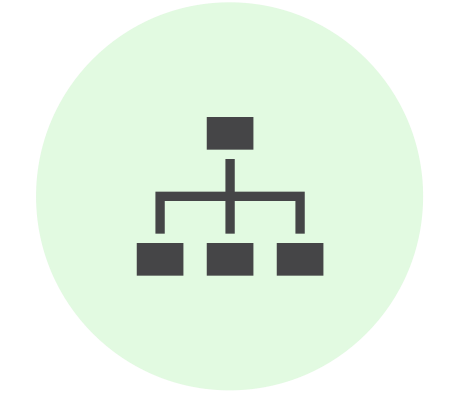5. Insights and lessons learned from the NBS pilot projects
In this chapter we synthesize key insights and learning outcomes from following the eight nature-based solutions (NBS) pilot projects. Section 5.1 provides a broad overview, capturing the themes and insights across all projects. Section 5.2 then presents nuanced experiences and perspectives, echoing the themes of section 5.1 but providing additional depth and detail. Our findings are categorised into distinct yet interconnected themes, reflecting common topics.
5.1 Overall insights from across the NBS pilot projects
Six common, overarching aspects emerged from studying the eight nature-based solutions (NBS) projects:
 | A supporting and enabling environment and leadership is central if NBS projects, or related actions, are new to the responsible organization. The project leaders played an instrumental role in the pilot initiatives. As pioneers, they needed to spend time communicating the benefits of the NBS project, not only to stakeholders but also people in their own organizations. |
 | Careful planning is an important component to be able to execute the NBS projects effectively. The pilot projects underscored the importance of appropriate planning specifically to ensure the multifunctionality of the NBS. |
 | Involvement and collaboration with various stakeholders, citizens and landowners is a key part of the NBS project work. A significant observation from the pilot projects is that collaborating with various actors proved essential, considering the socio-cultural and legal contexts intertwined with the NBS landscapes. |
 | Interdisciplinarity and multifunctional solutions: Combining different disciplines, types of knowledge, and roles is necessary to achieve multifunctionality of the specific NBS. The pilot projects have demonstrated that radical interdisciplinarity is beneficial, such as integrating social and natural sciences with communication, management skills and technical skills. |
 | Monitoring of effects of the NBS will be necessary after the end of the pilot projects to assess their long-term performance. This will require additional funding. |
 | Financing: The eight Nordic NBS pilot projects would not have taken place without funding from external sources. As such, the four-year NBS program of NCM has been essential to the projects and in getting these started. |
5.2 Detailed insights from the NBS pilot projects: Nuanced experiences and perspectives
In this section we present nuanced experiences and perspectives that emerged from interviews and interactions with the pilot projects, expanding upon the overarching themes outlined in Section 5.1. For empirical context, we connect the insights to the pilot project(s) in brackets.
The pilot projects are in this chapter referenced using the following codes: DK-R: Pilot 1- More Nature - Less Waste with brush fences (Denmark); DK-H: Pilot 2 - Planning for multifunctional land consolidation (Denmark); FO: Pilot 3 – Land restoration in the Faroe Islands; FI: Pilot 4 - Stream and watershed restoration in peatland and unproductive forest areas (Finland); IS: Pilot 5 - Crop wild relative biodiversity in urban green and coastal areas in Reykjavik (Iceland); NO: Pilot 6 - Protecting stream banks against erosion (Norway); SE: Pilot 7 - Floating wetland raft system for treating sea waters (Sweden); AX: Pilot 8 - Establishing multifunctional wetlands in agricultural areas (Åland).
5.2.1 Practical implementation of NBS (or relevant project activities)
All the eight pilot projects clearly articulated their interest in learning how to best go from plans and interest in using NBS to solve a certain challenge to on the ground implementation. As the pilot projects are not yet finished, they are still gaining valuable experience in this.
Getting to the practical implementation has in several pilots involved obtaining the necessary permits (NO, SE, FO), and this has taken some time, especially if one has not done it before. Also, several projects reported that finding the right competence and expertise (at the right time) was challenging, e.g., finding contractors to do the practical implementation work (AX). Furthermore, it was necessary or useful for project leaders to ensure timely follow-up on the agreed responsibilities of the people involved (FI). Being a team with diverse skills, including members with hands-on and field experience (SE), has been advantageous. Also, knowing the partners and having already built relationships and having worked together before (with a contractor, teacher, consultant etc.) in projects or other work made the practical implementation easier (FI, AX, FO).
A common experience of all the NBS pilot projects was that each site and area was unique and required both site visits and close dialogue with project partners and the stakeholders concerned. Natural conditions (soil properties, landscape, terrain etc.) and weather (e.g., storms, heavy rainfall, drought) sometimes presented challenges during practical implementation that were not initially anticipated, which underlined the importance of site visits. One might be lucky and find favourable conditions, but it is always good to do contingency planning and try to identify factors that might influence the timeline and timing of activities beforehand (AX, FO, IS). During practical implementation details are important, such as how exactly gravel is placed or where the excavator can drive in the landscape etc., as they influence the functioning of NBS (FI). It is necessary to follow up closely with contractors and entrepreneurs while the physical work is being carried out (NO, FI).
Implementation of NBS in areas with many interests, concerns and/or competing wishes for the use of land needs dedicated processes and coordination of actors in a meaningful way. This requires time and dedication, skills, and a mindset to be willing to listen and engage without having all the answers upfront (DK-H, DK-R), as experienced, in particular, in the Danish pilot project on multifunctional land consolidation (DK-H).
If you haven't done it before, you first need to find out which permits are required and who are the contact points for these?
5.2.2 Engagement, collaboration and communication
Overall, all pilots involve different actors and engage with stakeholders in one form or another, and their experiences and reflections are summarized below:
Outreach and communication early on can be valuable for NBS projects, as experienced by several of the pilot projects. The project leaders therefore advise doing substantial outreach and communication before and while the work is being done – not primarily when it is finished.
A related point is the fact that some stakeholders, like landowners, are key in order for measures to take place. NBS require available land/areas on which the solutions can be implemented.Several of the pilots have established contracts with the landowners to be able to conduct the pilots and/or planned interventions on the dedicated land areas (FO, FI, AX, DK-H). During the project works, the pilot project leaders also reflected on that some stakeholders may be sceptical towards the solutions. Actors may, if they are not involved and informed, choose conventional rather than NBS or the solution may not work as intended due to the site conditions which were uncounted for.
It is not always easy to identify who to engage or how to engage them, which was a common experience made by several pilots. While collaboration and involvement across different actors is described as very valuable, the aspect of coordinating and engaging the many different stakeholders and balancing interests, is also mentioned as challenging and involves investing time for it to be fruitful (AX, DK-R, DK-H).
It is not just about the environment; it is about the people.
Involvement also means meeting and engaging with people with different opinions and concerns. Several of the pilots have experienced meeting landowners and other actors, where some were positive, and others were more sceptical towards NBS. It was mentioned that this place some pressure on the pilot (team) to show that the intervention is/will be working. Negative feedback can come from landowners or others who see the pilot as a threat to current practices or from actors concerned about facing increased demands towards them. In such cases, all pilots mention dialogue and interactions with the landowners and other stakeholders as key. Also, within a sector, such as agriculture, interests and perspectives can be different at different levels e.g., agencies and institutions vs individuals. Some have experienced positive interest and support from individuals when there has been scepticism at the agency level.
Influencing people’s relationship with nature was identified as the aim of stakeholder engagement in several pilots (IS, FO, DK-R), but it was also expressed as a prerequisite for behavioural changes to support NBS (DK-R, IS, FO, NO), particularly in the case of owners and managers of land. A pleasant discovery for some of the pilots was to find that people understood why there was a need to address the problem the project was focused on (IS, DK-R). Some of the pilots have positive experience with involving students and school children as part of their key pilot work and activities (FO, DK-R).
Most of the pilots have received media attention and several shared that there was great interest both from the media as well from local politicians. Positive attention in the media may also make it easier to get new funding and has made it possible to engage at the political level and attract politicians (IS, DK-R, DK-H). Also, some projects have produced dedicated information materials and targeted marketing to engage specific citizen groups (DK-R).
One of the key challenges and joys is engaging citizens and stakeholders.
5.2.3 Financing and funding
Getting funding has been and still is a challenge for implementing NBS and/or doing multifunctional land use projects, this was mentioned by all the pilot projects. Before funding is provided for NBS projects, financial actors often want to see statistics about the expected results or performance of the NBS (DK-H, DK-R, FO). This information is often difficult to provide, especially in experimental NBS projects and upfront. It is also important to consider that different funding sources and programs come with different commitments and requirements, so it is wise to check these as part of the acquisition processes (SE).
In the case of the eight Nordic NBS pilot projects, funding from the NCM has been instrumental in getting the pilot projects going. The pilots consider that such NCM funding can be used as leverage to show first results and attract future funding, and that (positive) outcomes from these pilot projects can help to attract more funding. Unfortunately, most funding programs and mechanisms are only short-term and with no, or uncertain, follow-up opportunities, which makes it challenging for long-term planning (DK-H, FI, SE).
We need money annually, and we should know that we are getting that money annually. Now we are doing activities over some period, but we don’t know how to do the activities after these years.
5.2.4 Monitoring and evaluation
The pilots used different strategies related to monitoring the effects of the NBS. Some of the pilot projects had included baseline pre-action monitoring (NO, FI, IS, DK-H), some chose locations where an existing monitoring scheme was already in place (NO). Several had not budgeted for monitoring and, therefore, relied on external funding sources or their own funding for this purpose (SE, FI, FO). The monitoring is either conducted by the pilot team themselves, commissioning university partners (DK-R) or involving students in monitoring work (FO). The involvement of students in monitoring turned out to be an inspiring idea for other pilots as well who are now interested in exploring this approach in their future work (IS).
Monitoring is costly, so project leaders were thinking about how it could be done effectively (AX). Monitoring of effects on the natural environment should be continued for most pilots after the end of the pilot project period, because both the implementation and its developing effect on the natural environment takes time. Unfortunately, monitoring and evaluation beyond the pilot project period was (at the time of study) not arranged for most pilots. Some reflected on that monitoring and evaluation of NBS implementations should ideally be funded by the organizations funding the NBS itself and be a natural part of project planning and implementation.
Just one sample in the inlet and outlet does not say a lot.
5.2.5 Upscaling and mainstreaming
An aim with the NCM program and pilots on nature-based solutions (NBS) has been to promote the increased use and spread of new/best practices in NBS. The eight NBS pilots in the program address aspects of effective and efficient ways of implementing, organising and planning NBS in various ways.
Some are experimenting with and testing novel technical-natural approaches at small scale, so the next steps towards upscaling would be testing the methodology at a larger scale (SE). For others it is about getting similar or different actors (than those leading these pilots) to adopt the ways of working and taking the initiative to do similar interventions in their areas, e.g., for a municipality to initiate and conduct a similar NBS-related project (AX, NO, IS, DK-H, DK-R, FO). Some are engaging in method development and approaches for working on changing the ways in which we (humans) look at and interact with nature and natural resources (DK-R, IS, FO).
The pilot projects demonstrate how multifunctional and multi-actor land use planning could be done in practice and how such practices could be incorporated into politically adopted processes for future land use development and management (DK-H). Quite a few of the pilot projects will develop outputs such as different kinds of plans, guides, and knowledge synthesis, that can enable others to embark on similar projects. Furthermore, the pilot projects as results and experiences were starting to develop, appreciate the possibility to learn from one another.
Cooperation projects, seminars and fairs for further exchange of Nordic experiences would be much appreciated.
5.2.6 Challenges and barriers
The NBS pilot projects all agreed that doing new things for the first time takes more time than expected. It takes time before the NBS project materializes in reality, because one needs to involve different actors and manage their expectations, acquire the necessary funding, and there is often more paperwork involved (i.e. getting permits) than initially anticipated. This has not only been time-consuming but also challenging to balance the interests of different stakeholders and levels of governance, especially concerning the management of land ownership and land use rights (DK-H, FO).
Obtaining the appropriate competence and knowledge – both in planning and implementation, such as finding contractors with the required experience, was stated to be a challenge in several of the pilots (AX, NO). Similarly, enabling truly multi-functional land use can be challenging and requires dedicated focus (DK-H). As well, the process of managing several different actors is rewarding, yet time consuming (DK-R, DK-H).
In our study, we noticed that most of the pilot projects strongly depended on very committed individuals. The project leaders had a lot of responsibility and tasks that were demanding to manage alone. Processes and tasks requiring a lot of dedication and efforts from them, even when the project included dedicated collaborators.
It really takes a lot of time, the collaboration between public, civil and private actors....you can't be too result-oriented because it takes a long time.
5.2.7 Success factors and enabling conditions and mechanisms for NBS
Enabling conditions are the factors that support the adoption of nature-based solutions (NBS) and successful NBS projects. They can be of different type and character, both formal and informal, and include policies and management approaches etc. As such, the factors are wide-ranging and can include social or cultural beliefs, availability of information, and economic conditions.
When asked about success factors and what would enable successful NBS projects, the project leaders gave the following advice with respect to both the specific pilot experiences as well as related work:
- Tailor the solution to local conditions: Knowledge from other cases/regions needs to be adapted to the local context.
- Choose interdisciplinary teams and enable dialogue and collaboration across actors.
- A network of people is important for discussions and support when needed, including within the project group, as well as having connections to others outside the project, such as likeminded people (e.g., consultants, researchers). The establishment of a reference group early in the project can be wise.
- Acknowledge that many of the NBS projects are about the people and keep a focus on how to get the relevant actors, be it citizens and land users, owners, or others onboard, and how to do this effectively.
- Create a space with sufficient time and keep up the momentum, even if it's slow, as that's important for the collaboration.
- Allow and plan for some flexibility and unforeseen things that might occur.
- For NBS projects to happen there needs to be funding available. Having funding in place for actual NBS implementation is helpful in involvement processes, to demonstrate that this is real, and not just a potential plan that might not be carried through.
- Holistic thinking is crucial to be able to address the societal challenges at hand using NBS but also to ensure that the implemented solution does not cause damage elsewhere in an area and in the catchment.
- Include children and young people as NBS ambassadors.
- It is important to plan for participation, coordination, and engagement of various stakeholder groups and interests, including “bridge-building” between the involved organizations.
5.2.8 Key areas for future NBS knowledge development and support
As part of the study, we asked the pilot project leaders about which knowledge areas they considered to be lacking in information, where there is a need to develop more knowledge, e.g. what should future research projects focus on (knowledge gaps). The perspectives and answers were strongly related to the country where the pilot is situated, who is involved, and the kind of NBS they focus on, therefore also policy-related aspects were brought up.
Knowledge-related aspects:
Several of the pilot projects mentioned that a key focus going forward should be on gathering evidence on the effectiveness of different NBS. Creating systems to monitor the effects to be able to compare the effectiveness of NBS compared to conventional methods is incredibly important (NO).
There is also a need for the further development of systematic methods for implementing NBS at a larger scale, at landscape (D-H) and catchment level (NO). In the Faroe Islands, the project leader told us, there is a lack of research and knowledge on terrestrial ecosystems. There is a need for more public knowledge and learning about nature in general, to be able to see and understand degradation and how to protect ecosystems and local plants (FO).
Several pilots highlighted the need to further develop knowledge related to strengthening or changing citizens’ relationship with nature (IS, FO, DK-R), including emphasis on that NBS is about adapting and solving human-induced challenges on natures’ terms (AX). It is also relevant to improve the knowledge about NBS in education starting already at primary school (DK-R, AX).
The term ‘nature-based solutions (NBS)’ is still not defined or used in the same way everywhere. It was mentioned that it is important to use the correct terminology, including NBS, when applying for projects and funding, but that the term NBS is still not so commonly in use (AX).
Policy-related perspectives:
A catchment-based approach when addressing a specific problem, by mapping and considering measures for the entire watercourses, is important to avoid creating or moving problems elsewhere (NO). The project leader of the Norwegian pilot advised that the public authorities should support (through funding) the process-based part of NBS implementation so that the process can be holistic, considering the catchment as a whole and facilitating collaboration with several landowners and entrepreneurs in the catchment/area. In that sense, the operationalization of the Water Framework Directive (WFD) might be the correct avenue for such work with NBS.
Several of the pilot projects pointed toward gaps or lack of regulation and policies in different areas of environmental management (FO, IS, DK-H). The Icelandic pilot highlighted the need for a uniform international legal framework for genetic resources in the Nordic countries to ease collaboration (IS). The Danish Holmehave pilot pointed to the need to strengthen truly multi-functional land use programs and policies (DK-H). In some cases, the pilots have met barriers in the form of bureaucracy and complicated application processes (NO, FO). In other cases, the project leaders have pointed out that there is too little enforcement or restrictions on carrying out measures and interventions. For example, the project leader in the Åland pilot (AX) suggested that authorities could improve the requirements on how different solutions are carried out to avoid ponds with straight edges and to make the water flow more natural. There could also be potential for using compensation measures to a larger degree, for example, to require some areas to be restored to compensate for interventions in other places.
Getting stakeholders such as farmers involved should not just be about financial compensation for measures, to avoid everything just becoming a question of money. It should be communicated in a way conveying that this is important work to protect nature and biodiversity for future generations and that stakeholders can be proud of participating and doing their part (FO). In the Faroe Islands up until now there has been little focus on policies for nature protection, but a new law is now being implemented in 2024.
Several of the pilot projects highlighted the importance of enhancing cross-sectoral communication and collaboration. It was suggested to organize workshops or meetings for diverse stakeholders and sectors, aiming to foster dialogue about the implementation of nature-based solutions (NBS), while also taking different policies into account.
If people who work with land use, nature and politics are not involved, handbooks, guides and similar material on NBS is of little use.